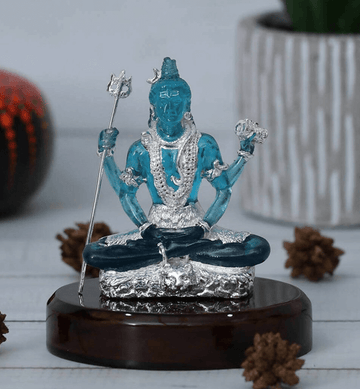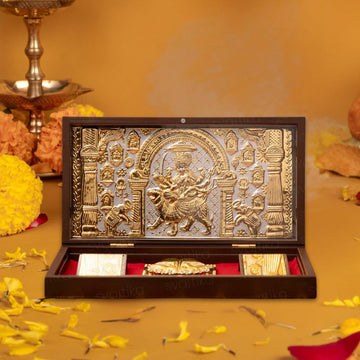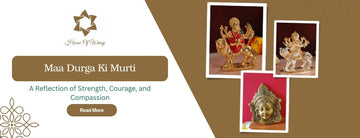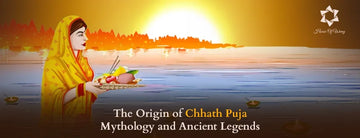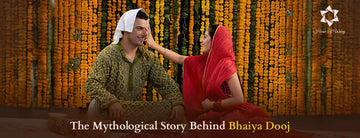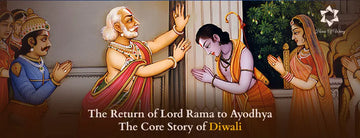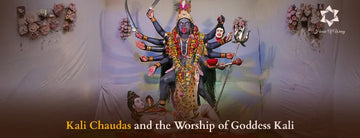Maa Durga Ki Murti: A Reflection of Strength, Courage, and Compassion
Discover the deeper meaning behind Maa Durga’s divine form
Have you ever found yourself in front of a magnificently carved Maa Durga ki murti, finding your internal state calmer, more powerful, and reverent? In that moment, your experience is not only emotional, but it is spiritual. For millions of worshippers around the planet, the energy of Maa Durga does not simply inhabit temples; she inhabits her murti, and the murti possesses layers of symbolic vim weighing on the centuries of spirit it moves.
In today's hurried, chaotic, and sometimes disconnected existence, the home from the root of your origin, a Maa Durga murti, can provide a sacred pause, reminding you every day that strength can be graceful, courage can be compassionate, and divine power can protect.
The Symbolism of Maa Durga's Appearance and Form
Maa Durga, the goddess of Hinduism, is not merely a display of splendor; she is a multifaceted message. When depicted in a red saree or dress, red denotes activity and strength. She is often seated on a lion, which is quite appropriate, because she remains calm and composed when surrounded by chaos.
Her countenance may appear serene and peaceful, or passionate with intensity; based on the form and symbolic value, the onlooker views the goddess as an equal blend of loving care and fierce protective power. Her jewelry does not signify her wealth; it signifies the spiritual riches she embodies to share with her devout followers. She crowns herself spiritually and shines with divinity, and her third eye denotes awareness higher than the physical realm.
The Meaning of Maa Durga's Multiple Arms
Maa Durga is also depicted with ten arms, every single one carrying an arm or icon of another deity; she depicts a conjoining of all gods' power to show how profoundly powerful she is. The ten arms are not merely to use in war; they signify that she contains total force and strength to patrol wickedness as she guards dharma simultaneously.
She is the only goddess with this cosmic multitasking potential - therefore, she is an ideal personification of Shakti, the divine feminine energy which sustains life and nourishes all! It reminds all who worship her, especially women, that you can be many things all at once - gentle, fierce, protective, creative, and powerful.
Maa Durga Statue Significance with Lion
The lion or tiger, Maa Durga's vehicle, represents bravery, tenacity, and wild energy. She rides on the lion instead of sitting next to it. Inner control is symbolized by this imagery. She harnesses the beast's power rather than suppressing it.
The lion serves as a reminder to face our inner fears and live courageous lives for those who are putting a Durga statue in their homes. We are reminded to face our inner demons of ignorance, anger, and doubt just as she bravely faces Mahishasura.
What Each of the Weapons in Maa Durga's Hands Means
Overcoming physical, mental, and spiritual pain is symbolized by the Trishul (Trident).
-
The Sudarshan Chakra is a representation of cosmic balance and dharma.
-
Sword: Provides wisdom by slicing through ignorance.
-
Bow and Arrow - Harmony between potential and action.
-
Lotus - Spiritual awakening in the material world.
-
Conch - Vibration of the universe; pure sound.
-
Club/Mace - Emotional strength and mental discipline.
-
Snake or Thunderbolt - Energy and transformation.
-
Shield - Protection from negativity.
-
Bell - Alerts the senses, signifies awakening.
The Durga murti symbolism, which serves as a spiritual tool for introspection and personal development, is present in each of these components.
The Creation Story of Maa Durga: Mahishasura's Slaying
In the Devi Mahatmya of the Markandeya Purana, the story of Mahishasura stands as a timeless allegory. Blessed with invincibility against all men, Mahishasura terrorized the heavens. The gods, powerless against him, combined their divine energies to create Maa Durga, the invincible feminine force.
Her battle with Mahishasura wasn’t just physical; it was spiritual warfare against ego, ignorance, and imbalance. Her victory reinstated dharma. This Goddess Durga spiritual meaning remains deeply relevant, reminding us that real strength arises when we confront our darkness with clarity and devotion.
Maa Durga’s Compassion: The Motherly Aspect of Her Power
Despite her fierce avatars, Durga remains Devi Ma, the universal mother. Her compassion is vast, often misunderstood due to her warrior form. She protects like a lioness, fierce when her children are in danger, soft when they come seeking shelter.
Those who worship her not only seek protection but also emotional healing, motherly comfort, and spiritual support. Many believe that during Navratri Durga idols, her energy actually descends into the murti, making the connection between devotee and deity intensely personal.
Maa Durga’s Murti in Different Poses: Symbolizing Various Qualities
-
Mahishasura Mardini Pose - Valor and righteousness.
-
Santoshi Maa-like Smiling Pose - Peace and contentment.
-
Annapurna Form - Nourishment and abundance.
-
Ashtabhuja Durga - Mastery over multiple faculties.
Every pose carries a message. When choosing a murti, the form you pick should resonate with your inner journey and household intentions.
The Importance of Maa Durga’s Murti in Rituals and Worship
The murti is the spiritual core of homes, temples, and particularly at the Durga Puja. During the nine-day period of Navratri, devotees will perform sthapana (installation of the murti) and behave as though she is a living being by feeding her, praying to her, singing, and dancing for her.
However, Durga murti symbolism is not limited to the weapons. It also relates to how the murti is placed, the lighting, the mode of worship, and the placement of the murti. In Hindu understanding and myths, murtis that face east receive the purest cosmic energy.
Choose the Right Maa Durga Murti for Your Home or Altar
When selecting a Maa Durga ki murti, consider:
-
Material - Brass, wood, marble, and clay are traditional. Brass and marble are best for permanent installations.
-
Size - Choose based on space and purpose. Small for personal altars, large for community spaces.
-
Posture - Meditation for peace, warrior for strength, smiling for abundance.
-
Numerology - Murtis with 8, 10, or 18 arms hold specific meanings; consult a pandit if needed.
At the house of Wemy, we provide skillfully designed Durga Puja idols that pay homage to these traditions. Each one is not only art, it's heritage.
The Role of Maa Durga in Durga Puja and Other Festivals
At Durga Puja, the murti is not just a symbol; she becomes the Goddess herself. Lovingly made, reverently painted with vermilion and bright colors, worshiped for nine long days, her immersion on Dashami is both a heavenly farewell and assurance that she never fails to come back.
In weddings, housewarmings, and new beginnings, gifting a Maa Durga idol meaning a blessing of Shakti and protection.
The Influence of Maa Durga in Modern-Day Worship
In today’s globalised lifestyle, where many Indians live far from their ancestral roots, the presence of a Maa Durga ki murti in one’s home becomes a sacred tether. It connects modern living with eternal dharma. Her form brings clarity during confusion, strength during uncertainty, and peace amidst chaos.
Digital aartis, virtual pujas, and community gatherings abroad show that the power of Maa Durga transcends geography and time. Even in the smallest apartments, her murti stands for strength and courage Maa Durga spreads.
Ending Message
Hindu Goddess Durga is not merely a goddess. She is an emotion, a force, a mother, a warrior, and a friend during darkness. Her murti is a reflection, reflecting us to what we can become if we tread the path of dharma with utmost belief.
As you reflect on your own journey, ask yourself:
Which form of Durga resides within me today? The nurturer? The protector? The seeker?
Explore the House of Wemy’s curated collection of Goddess Durga Idols, designed to bring this divine presence into your home, crafted not just with hands, but with heart, heritage, and humble reverence.

